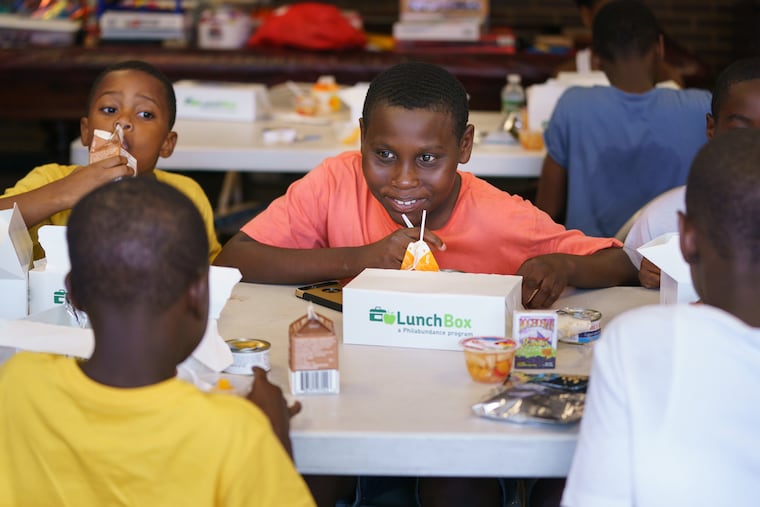Summer is a hungry time for low-income kids in the region
Kids aren’t in school, so they’re not getting free and reduced-price lunches. To feed low-income children, 1,159 summer-meals sites have been set up in the five-county Philadelphia region since June.

Paris Burgess, all of 11, had a secret about her South Philadelphia block to impart.
“Some people in this neighborhood don’t have enough to eat.”
Kids like Paris who attend the Ford Police Athletic League Center on Snyder Avenue are excited because the facility is addressing the problem of hunger and is, for the first time, serving lunch to its 27 camp kids this summer, thanks to food from Philabundance, the hunger-relief agency.
Paris’ friend, Savanah Riley Uqdah, 7, who had just finished eating tuna salad the other day, echoed the idea that too many families do without, especially in summer. “People feel hungry here because they don’t have enough money," she said. "That’s why people are here — to eat.”
When it comes to hunger, good weather masks bad times.
The temperature’s up, and the sun doesn’t set until deep into the evening.
But for low-income people, summer is the hungriest time of year. Kids aren’t in school, which means they’re not getting free and reduced-price lunches (and breakfast). To compensate for meals they can’t afford to provide, parents flock to food pantries.
The problem is, donors who normally give food and money to pantries save their largesse for the colder months and the late-year holidays, unaware that family food emergencies often come dressed in summer sandals, not just winter boots.
“There’s a huge demand on our food network, and we see the least amount of donations,” said George Matysik, executive director of Share Food Program, a Hunting Park nonprofit that supplies food to hundreds of pantries in the region.
“Summertime is the height of economic uncertainty for so many families.”
Summer feeding
Agencies do what they can to feed low-income children during the summer. The Philadelphia Department of Parks and Recreation, the Philadelphia Housing Authority, Philabundance, Nutritional Development Services of the Archdiocese of Philadelphia, and some 15 other organizations provide food in camps and other programs, most of it funded by the federal government.
Since schools closed in June, 1,159 summer-meals sites were set up in the five-county region — 944 in Philadelphia, 215 in Bucks, Chester, Montgomery, and Delaware Counties, according to Kathy Fisher, interim executive director of the Greater Philadelphia Coalition Against Hunger.
Yet, a meals gap persists, Fisher said.
For example, in October 2018, Philadelphia public and parochial schools served about 134,000 free and reduced-price lunches to low-income students on an average day, Fisher said.
But in July 2018, approximately 50,000 summer meals were provided to Philadelphia children on an average day, she added.
“That means summer meals are reaching less than 40 percent of kids getting lunch during the school year,” Fisher concluded. “This is well above the state [14 percent] and national [14.1 percent] rates. But there’s still room for very significant improvement.”
Earlier this week, the Washington, D.C.-based Food Research & Action Center, the largest anti-hunger lobbying group in America, released a report that depicted a significant Pennsylvania-wide meals gap between the school year and summer. It also disclosed that Pennsylvania is feeding fewer children in the summer than it did in the past.
According to FRAC, during the 2017-18 school year (the latest data available), 638,000 Pennsylvania children received a free or reduced-price lunch on an average school day. But in July 2018, only about 89,000 Pennsylvania children received a summer lunch. This means that just 14 of every 100 low-income kids who got school lunch also ate summer lunch, FRAC reported. Pennsylvania ranks 28th out of all 50 states in this regard.
Furthermore, 4.4 percent fewer kids in the state are getting summer meals than in July 2017, according to FRAC.
The drop-off is attributed to a number of feeding sites ending their programs, said Ann Sanders, public policy advocate for Just Harvest, an anti-hunger nonprofit in the Pittsburgh area.
The reason? While it funds much of the food given to children in summer feeding programs, the U.S. Department of Agriculture doesn’t pay for all the people who distribute the food. “That makes it hard for nonprofits to run programs that provide summer lunch,” Sanders said. “Someone has to pay the labor.”
Faces light up
At the Ford PAL Center the other day, director Joseph Ellerby, a Philadelphia Police officer, marveled at the food the summer camp now provides. It’s supplied by Philabundance, not the federal government, through its LunchBox program, which expects to distribute 57,000 meals this summer.
“The joy that we feel when we see our kids eating a well-balanced meal, having their hunger satisfied — well, it’s remarkable,” Ellerby said.
Kids at the PAL site are getting barbecued chicken, fruit cups, hummus dip, tuna salad, and more.
“So many families here live below the federal poverty line [$21,330 for a family of three],” said program associate Dana Randolph. “They have no resources to provide healthy meals at lunchtime in the summer.”
Randolph observed that the hungriest children are the quietest when the food is served. “Some are ashamed to have that need,” she said. “But this food relieves family pressure.
“And you should see the kids’ faces light up when they realize there’s food for them to eat.”